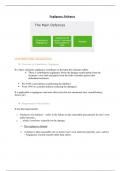Summary
Summary Defences- CN, Volenti & Illegality: Law of Tort (LAWD10011)
- Module
- Law of Tort (LAWD10011)
- Institution
- University Of Bristol (UOB)
An in-depth summarised and collated notes regarding the three main defences in negligence which includes case summaries with annotations to important quotes and flow-charts for easy answering of PQ's.
[Show more]



